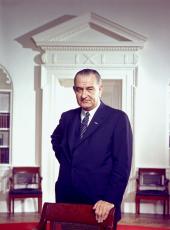
Statement by the President on the Treaty for the Prohibition of Nuclear Weapons in Latin America
One year ago today, on February 14, 1967, the nations of Latin America gathered in Tlatelolco, Mexico, to sign a Treaty for the Prohibition of Nuclear Weapons in Latin America. Twenty-one nations of the region have now joined in this historic undertaking.
The United States considers this treaty to be a realistic and effective arms control measure of unique significance--not only to the peoples of Latin America, but to all the peoples of the world.
Today I am pleased to announce that the United States will sign Protocol II to this treaty which calls upon the powers possessing nuclear weapons to respect the status of denuclearization in Latin America and not to use or threaten to use nuclear weapons against the Latin American states party to the treaty. I have appointed Adrian S. Fisher, Deputy Director of the Arms Control and Disarmament Agency, as my emissary to sign the Protocol in Mexico with an appropriate statement.
Upon ratification by the Senate, the United States will assume the obligations to those countries within the region which undertake and meet the treaty's requirements. I am pleased to note that the drafters of this treaty have indicated that transit by the United States within the treaty zone will continue to be governed by the principles and rules of international law.
The Treaty of Tlatelolco has been closely related to the long effort to reach worldwide agreement to prevent the further spread of nuclear weapons. It will create a nuclear free zone in an area of 7 1/2 million square miles, inhabited by nearly 200 million people. Like the Nonproliferation Treaty, this treaty, in addition to prohibiting the acquisition of nuclear weapons, also prohibits the acquisition of nuclear explosive devices for peaceful purposes. However, it has been drafted in such a way as to make it possible for Latin American parties to the treaty to obtain peaceful nuclear explosion services.
It is indeed fitting that this giant step forward should have had its genesis in Latin America, an area which has come to be identified with regional cooperation. I particularly wish to congratulate our distinguished friend, President Diaz Ordaz of Mexico, for the initiative and leadership which his Government has contributed to this treaty and thereby to the peace of this region and of the world.
In signing this Protocol, the United States once again affirms its special and historic relationship with the peoples of Latin America and its stake in their future. The United States gives this affirmation gladly, in the conviction that the denuclearization of this region enhances the development of its peaceful nuclear potential.
Note: On March 25 the White House announced the President's designation of Vice President Humphrey to sign Protocol II of the treaty on behalf of the United States at ceremonies to be held in Mexico City on April 1. Deputy Director Adrian S. Fisher of the Arms Control and Disarmament Agency was prevented by illness from attending the signing. The full text of the announcement is printed in the Weekly Compilation of Presidential Documents (vol. 4, p. 576).
The text of the treaty is printed in the "Seventh Annual Report to Congress of the Arms Control and Disarmament Agency, January 1, 1967 to January 18, 1968," pages 65-77 (Government Printing Office, 1968). The Vice President's remarks at the signing ceremony, together with the text of Protocol II, are printed in the Department of State Bulletin (vol. 58, p. 554).
Lyndon B. Johnson, Statement by the President on the Treaty for the Prohibition of Nuclear Weapons in Latin America Online by Gerhard Peters and John T. Woolley, The American Presidency Project https://www.presidency.ucsb.edu/node/238946
